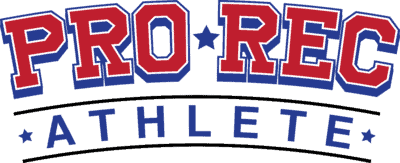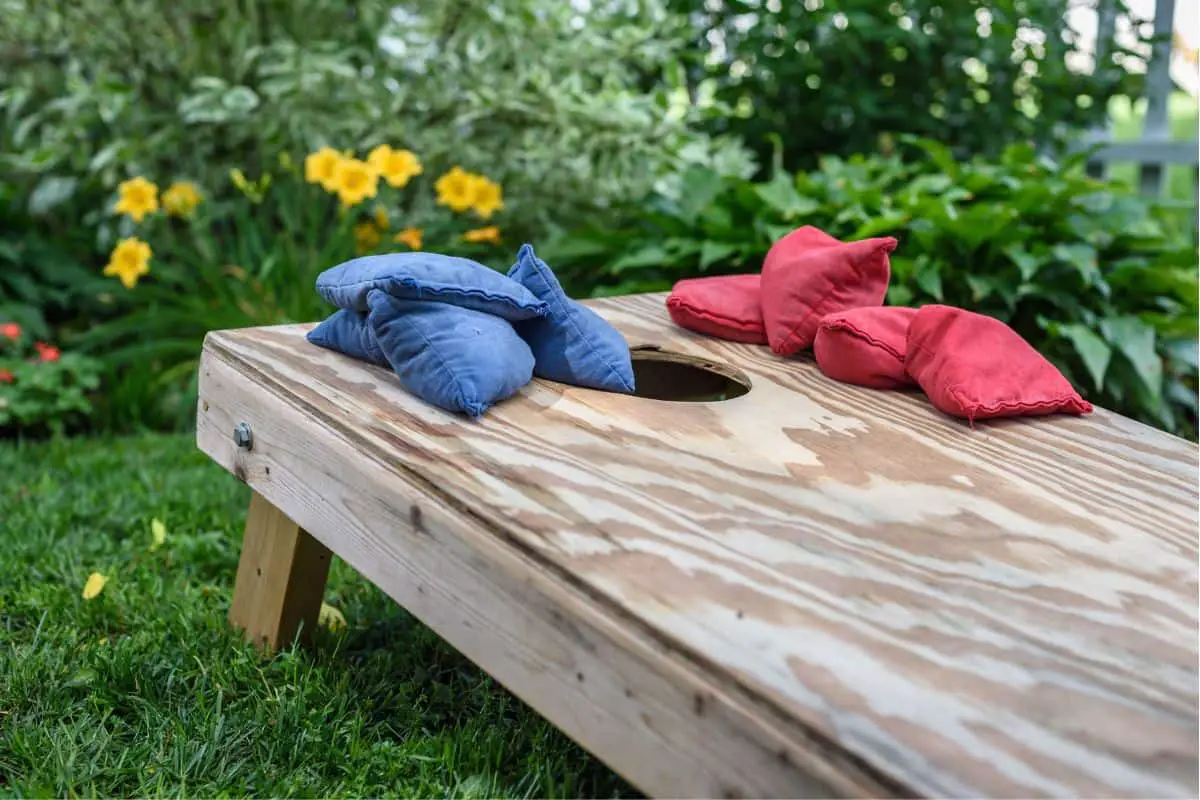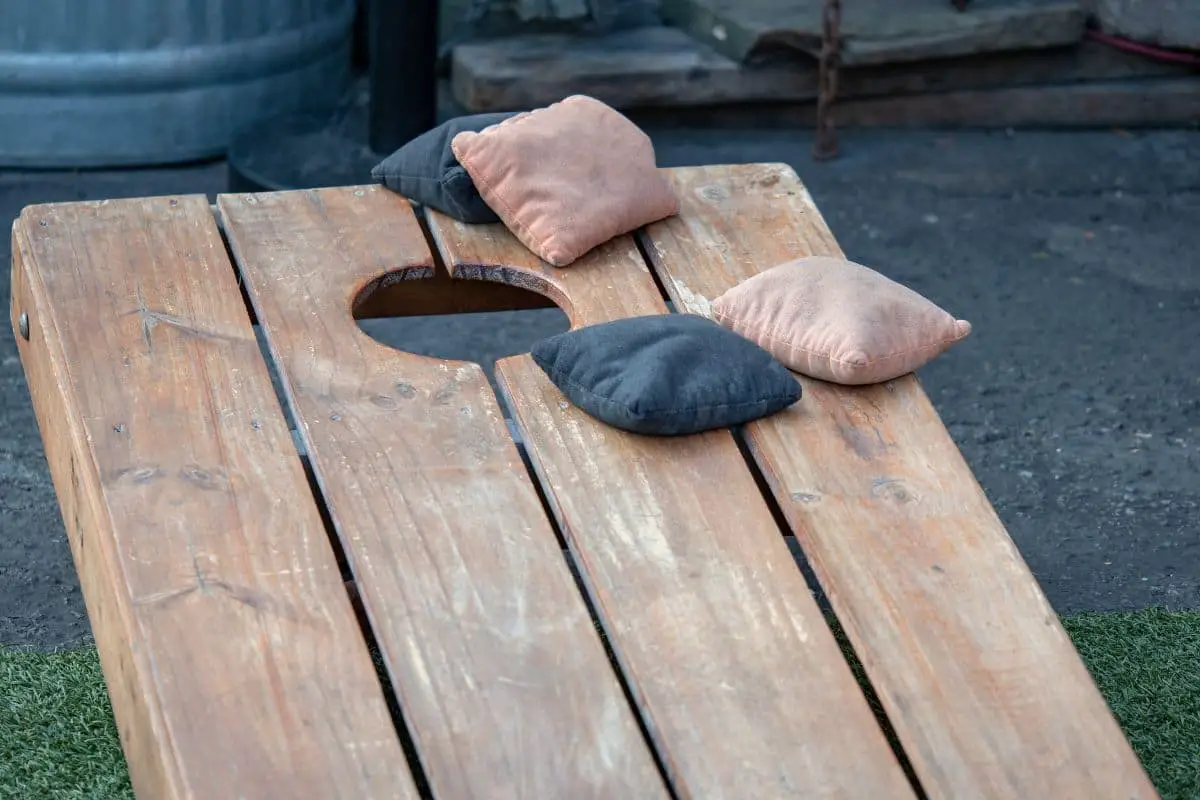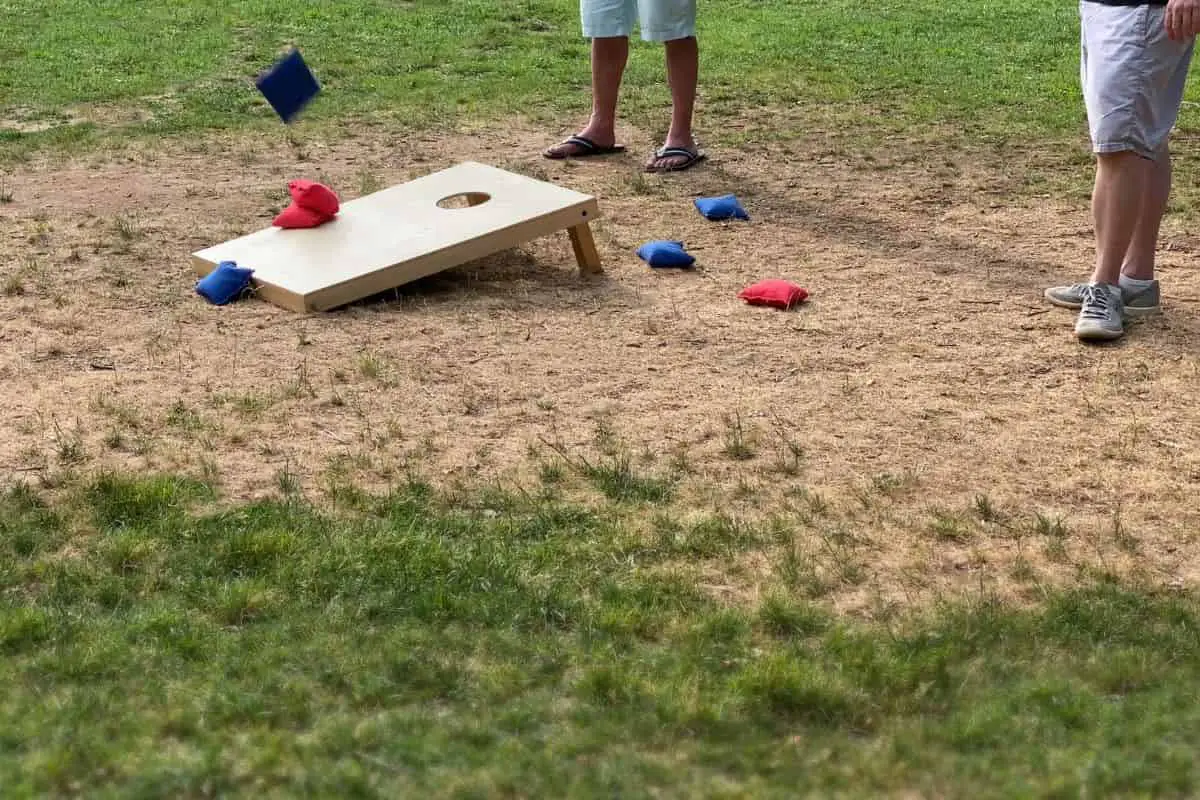Cornhole is a fun, simple game. All you need to play the game are cornhole bags (similar to bean bags) and a cornhole board. But what if you’re just a newbie? What can you do to learn, enjoy, and get better at the game?
Here are 20 cornhole tips for beginners, from buying equipment to throwing your first cornhole bag to playing your first tournament.
1. Don’t Overspend on Bags
There’s a vast market out there for expensive, high-end bags. Many of them claim that they’ll improve your game, help you throw farther, etc. Don’t worry too much about starting your cornhole journey with pro-level equipment.
Getting better at cornhole is a matter of skill, not so much equipment. Working on your technique and learning how to throw will help your game worlds better than spending hundreds of dollars on cornhole bags.
You don’t need $100 or more bags to become great at cornhole. Just practice your throwing, stance, and throwing angle. Then, if you do decide to go for more expensive bags, you’ll have the skill to enjoy them.
2. Invest in a Well-Made Board
While you don’t want to overspend on bags to start, investing in a well-made, solid board that can last you a lifetime is a good idea. Again, some cornhole boards are overpriced, especially when you factor in special graphics or branded logos. You shouldn’t be paying more than $300 for a decent, simple board.
The primary selling point of a good cornhole board is going to be its durability, heft, proportions, and thickness. You want something simple yet well-made that you can practice and compete on for years to come.
It doesn’t need to be fancy, but it should be built well, and in line with official cornhole board specifications. If you can’t afford a high-quality, basic board, that’s ok. You can start cheaper, save money, and go for a better board in the future.
You may even consider building your own board. It’ll save you some money, and allow you to build something you’ll be proud of with your own hands, as you embark on your new hobby.
3. Relax Your Muscles and De-Tense Your Body
Don’t tense up too much! Relax, have fun, and come to the game with a sense of adventure and with an open mind. The calmer you are, the less you’ll tense up and the better you’ll do. Try wiggling your arms and legs or taking a lap around the yard to help your muscles relax.
Focus, but don’t panic. Cornhole is an easy game, and no matter what your skill level is, you can learn and enjoy this sport! It’s not complicated like baseball and doesn’t take F1-level reflexes. Just relax, and use these positioning tips to help you get the best angle to throw.
4. Put Your Dominant Foot Forward
If you throw with your right hand, make sure to put your right foot forward slightly as you position yourself to toss. This will give you a bit more distance and allow your body greater stability. If you’re a lefty, put the left leg forward slightly.
Bend the dominant leg slightly, and keep it flat on the ground. This will help you keep your balance as you throw, and keep the path of the corn bag straighter, too. Don’t lift at all on your dominant leg. The more contact with the ground this leg has, the better distance and consistency you’ll get.
5. Grip Your Corn Bag Flat
You’ll want to hold your corn bag flat and grip it with moderate force. The flatter your corn bag is when you toss it, the farther it will sail. Think of a frisbee in flight.
Grip with your thumb on the upward-facing side, and your four fingers on the opposite side. You can dig into the inner resin, rice, or beans a bit to create a sort of handle as you throw. This gripping method will help your corn bag fly farther, make it more natural to release, and allow you to focus more on the hole as you toss.

6. Keep Your Eyes on the Hole
Don’t focus on the board itself, and don’t get distracted by things going on around you. Instead, keep your eyes on the hole in the board. The goal is to get as close to the hole as possible. The more focused your gaze is, the more likely you are to throw properly and aim better.
Keep your eyes on the hole before, during, and after you throw. This will keep your body more stable and lined up fully with your target. If you have vision problems, wear your corrective lenses! The less blurry or off-kilter everything looks, the better your aim will be.
7. Keep Your Arm Rigid, Not Bent
Keeping your arm rigid will allow you greater distance and give you a more predictable arc. A rigid arm will also give you a more powerful throw, as less of your body’s kinetic energy is wasted in muscle tension.
Think of your throwing arm as the arm of a catapult, and keep it rigid yet relaxed. Use it as a tool, and envision your throwing arm as an extension of your mind’s goal. This will help you stay relaxed and effective as you toss.
8. Wind Up and Throw At Chin Level
Give your throwing arm a moderate wind-up, with enough of an angle to give speed, but not so much that your arm feels uncomfortable or strained. Keep your arm rigid, and as you throw bring your bag up to about chin level before releasing.
This will help keep your corn bag level with your eyes, and if your eyes are fixed on the board’s hole, you’ll get better distance and better aim, too. Releasing before or after this point can cause a lackluster throw.
9. Toss Your Corn Bag Up and Away
Tossing flat with no arc is going to cause your bag to fall short of the mark. You want to throw your bag for lift as well as distance and tossing upwards a bit as you throw will give you greater range.
You want your cornhole bag to sail a bit, and fly some. Giving the pitch a hit of height will help your bag travel well and give it a better chance of hitting its mark. This move can also help those with a slightly weaker pitch, or lower muscle mass.
10. Don’t Rotate the Wrist
You might be used to throwing a frisbee at an angle, but you’ll want to avoid any fancy wrist work when tossing a cornhole bag. A corn bag is fairly solid and is not designed to sail or glide like a disk. Keeping your wrist straight and lined up with your target will give you a better chance of making a hole.
11. Lift Off Slightly with Your Non-Dominant Foot
As you throw the corn bag, feel free to step off of your non-dominant foot a little as you throw, while keeping your dominant foot firmly planted. This light lift will give you a bit more distance, let you aim straighter, and provide you with better balance as you throw.
Find a throwing method and a lift angle that works best for you. If you have issues with balance and feel more comfortable not lifting off at all, don’t sweat it. Just do what works for you, stay safe, and be comfortable. One can also throw well with both feet planted on the ground, too.
12. Experiment with Positioning
While the cornhole board will be a set distance away at a competition, in your backyard you can get as close to the board as you need to. Start close, get the hang of things, and begin to move further from the board as you get more comfortable with the mechanics of the game.
You can also experiment with alignment. Do you throw better standing slightly to the right of the hole? Or to the left? Where do your bags tend to land, and can you adjust your wrist position or your stance to make changes?
Don’t be afraid to take your time and find out what works for you. There’s no pressure, everyone throws differently, and it will take time to learn what works best for your body type.
13. Pace Yourself
If you’re competing casually as someone new to the game, don’t let more experienced players’ speed or pace intimidate you. Go as slowly as you need to, line up, and throw at a timing that makes sense for you.
If you rush yourself, you’ll panic, become self-conscious, and miss. Relax. You’re here to learn, have fun, and improve your game, not to take home a trophy. Take breaks for water, stretching, and deep breathing to help you slow down, and enjoy the experience.
14. Don’t Stress About Points
When you’re getting started learning cornhole, the last thing you want to do is stress about points or focus on winning. Instead, focus on learning how to throw and aim and getting a feel for the game. Enjoy yourself, relax, and know that it can take years to get excellent at cornhole.
If you hit the board, celebrate that. If you get only one hole in a week, that’s great! Keep practicing, keep letting your body tell you how to throw, and keep learning from your mistakes. Take it easy, and you’ll learn faster and enjoy the process even more.

15. Start Simple in Your Backyard
Before you hit a cornhole tournament, practice. Find a safe, quiet place to practice your throwing, stance, and distance. Those who truly love and succeed at something are those who start with a simple love for the activity.
Give yourself plenty of time, practice for as long as you want to, and learn to enjoy the game for its own sake. When you start simple in your backyard, you’re also starting at a pace and in an environment meant to help you get comfortable and hone your skills.
16. Practice as Often As You Can
You won’t get great unless you practice. Go easy on yourself, but set aside time every week to work on your game and get a feel for the sport. The more time you spend with the sport, the more used to throwing your body becomes, and the more you practice, the more naturally you’ll learn and excel.
No cello player or chess master ever got great at their passion on day one. Keep practicing, listen to your body, have fun as you get better, and reward yourself for milestones. Did you get three holes today? Celebrate with a small snack, drink, or trip out for ice cream. Keep your passion fun, and you’ll be coming back to it more often.
17. Face Off Against Friends
Getting better at cornhole by yourself is great, but teaming up with friends can help make the game even more enjoyable. You can learn from one another as you play, and a bit of friendly competition can help spurn you to do even better.
Have friendly competitions in your backyard and learn from one another. The best thing about cornhole is that anyone can learn it, and the simplicity of the game can attract friends to help you as you practice.
18. Don’t Be Afraid of Tournaments
While playing in your backyard is a great way to warm up and gain skills, don’t be afraid to attend a cornhole tournament. Even if you can’t compete formally, seeing how others play, being around other cornhole players, and talking to professionals can be a really rewarding and fun experience.
You’re there to learn, socialize, and enjoy the company of other cornhole enthusiasts. You don’t have to be an expert to enjoy being around other hobbyists; sometimes, meeting and talking with pros can help reignite your love of the game.
19. Learn from the Pros
If you’re at your first tournament, take the opportunity to learn from the pros. Not just the mechanics of the game, but their journey with cornhole, what got them started, and their favorite equipment to play with.
Take the time to get an autograph, ask a couple of questions, and enjoy the experience. Getting to meet professional cornhole players can be fun, and eye-opening and may even help inspire a podcast, YouTube channel, or blog of your own.
20. Have Fun!
This is the most important rule of all. Cornhole is simple and isn’t meant to be stressful. While many take the game seriously, enjoying the sport and growing as a player is going to be your key to success. The biggest tip for those beginning with cornhole is to enjoy yourself, relax, and allow yourself to get into the game at a pace that makes sense for you.
Also, there are online discussion groups where you can talk to other players, learn, get tips, and share photos and videos of your new hobby. The one thing that makes any sport or hobby a blast is passion. Keep that enthusiasm alive, practice, and above all, enjoy yourself.



